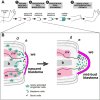Advances in Decoding Axolotl Limb Regeneration
- PMID: 28648452
- PMCID: PMC5534018
- DOI: 10.1016/j.tig.2017.05.006
Advances in Decoding Axolotl Limb Regeneration
Abstract
Humans and other mammals are limited in their natural abilities to regenerate lost body parts. By contrast, many salamanders are highly regenerative and can spontaneously replace lost limbs even as adults. Because salamander limbs are anatomically similar to human limbs, knowing how they regenerate should provide important clues for regenerative medicine. Although interest in understanding the mechanics of this process has never wavered, until recently researchers have been vexed by seemingly impenetrable logistics of working with these creatures at a molecular level. Chief among the problems has been the very large size of salamander genomes, and not a single salamander genome has been fully sequenced to date. Recently the enormous gap in sequence information has been bridged by approaches that leverage mRNA as the starting point. Together with functional experimentation, these data are rapidly enabling researchers to finally uncover the molecular mechanisms underpinning the astonishing biological process of limb regeneration.
Copyright © 2017 Elsevier Ltd. All rights reserved.
Figures


References
-
- Spallanzani L. Reproductions of the legs in the aquatic salamander., in An Essay on Animal Reproductions [Prodromo di un opera da imprimersi sopra la riproduzioni anamali] Becket and de Hondt; London: 1769. pp. 68–72. [Italian: 1768]
-
- Schreckenberg GM, Jacobson AG. Normal stages of development of the axolotl. Ambystoma mexicanum. Dev Biol. 1975;42(2):391–400. - PubMed
-
- Bordzilovskaya NP, Dettlaff TA, Duhon ST, Malacinski GM. Developmental-stage series of axolotl embryos. In: Armstrong JB, Malacinski GM, editors. Developmental Biology of the Axolotl. Oxford University Press; New York: 1989. pp. 201–219.
-
- Sobkow L, et al. A germline GFP transgenic axolotl and its use to track cell fate: dual origin of the fin mesenchyme during development and the fate of blood cells during regeneration. Dev Biol. 2006;290(2):386–97. - PubMed
Publication types
MeSH terms
Substances
Grants and funding
LinkOut - more resources
Full Text Sources
Other Literature Sources
Miscellaneous

